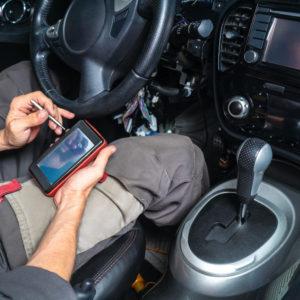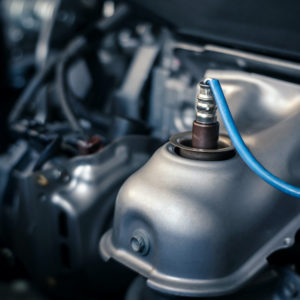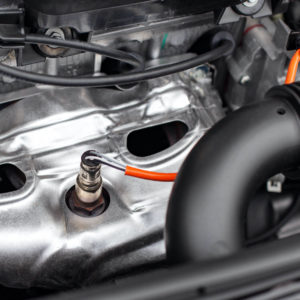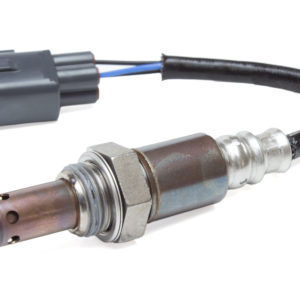Decreased fuel efficiency, a rough-running engine, and an illuminated check engine light can point to a lot of issues. However, if your OBD-II scanner stores the P0132 code, there is a problem related to one of your oxygen sensors.
In this article, we discuss what code P0132 means, as well as its symptoms and causes.
What Does the P0132 Code Mean?
Diagnostic trouble code (DTC) P0132 stands for “Oxygen Sensor Circuit High Voltage (Bank 1, Sensor 1).” It involves the vehicle’s oxygen sensor, specifically the #1 sensor on Bank 1. This code is triggered when the PCM or powertrain control module detects that your heated oxygen sensor reading is too high.
This can indicate that the oxygen sensor is responding too slowly to the air-fuel mixture in your engine.

This happens when the oxygen sensor voltage stays above a certain threshold for a select amount of time. The code is also triggered if the air-fuel ratio stayed in a rich-biased condition for too long.
Take note that what’s considered as “too long” varies depending on your vehicle’s make and model.
What Do Oxygen Sensors Do?
The primary purpose of oxygen sensors is to check the amount of unburned oxygen in your vehicle’s exhaust stream as it exits the engine. They are located within your vehicle’s exhaust system.
For an in-depth discussion of O2 sensors and how the PCM detects issues, read our technical explanation about rationality checks.

What are the Possible Causes of the P0132 Code?
OBD-II code P0132 may be triggered by a number of causes, which may vary depending on your vehicle’s make and model. Here are the common triggers of code P0132:
- Rich running condition
- Circuit problems, such as damaged wiring and loose connections
- Faulty O2 sensor
- Malfunctioning PCM
- Outdated PCM Software

What are the Common Symptoms of the P0132 Code?
Symptoms related to code P0132 may vary depending on your vehicle’s make and model. Aside from a bad smell or black smoke coming out of the exhaust, here are the other common symptoms related to the P0132 code:
Rough Running Engine
This is the most noticeable symptom related to code P0132. If your engine is not running as smoothly as before and you’re also experiencing rough idling, there is a chance that something is wrong with your oxygen sensors.
Decreased Fuel Efficiency
Since your oxygen sensors play a vital role in fuel injection, any issues may increase your fuel consumption. If you notice that your vehicle is consuming more fuel than usual, it is best to have your vehicle checked.
Illuminated Check Engine Light
An activated check engine light is a clear indication that something is wrong with your engine. Once it illuminates, it is best to have your vehicle checked immediately.
How to Diagnose the P0132 Code
Many problems can trigger a P0132 code, from a bad oxygen sensor to a defective mass airflow sensor. Unless you’re an automotive specialist, you may have a hard time determining its underlying cause.
Let your trusted mechanic diagnose the issue if you are not confident with your automotive know-how. However, if you’d prefer to try your hand at diagnosing your P0132 code, watch the video below to get an idea of the troubleshooting process:
How to Fix the P0132 Code
Like most OBD-II codes, there is no one way to resolve the P0132 code. The right fix varies based on what triggered the code and the vehicle’s make and model. This means that the solution to a P0132 code in a Honda Civic may not work as well for a Dodge Durango.
If you are confident with your automotive aptitude, identify the cause of the P0132 code using the video above. Once you’ve accurately diagnosed the issue, you can figure out how to resolve it by doing your research on the steps others with the same vehicle have taken in order to clear the P0132 code.
You can also make use of online auto repair resources and guides—and don’t forget to check your owner’s manual before implementing any solutions.
Also, consider securing an ALLDATA single-vehicle subscription to prepare for any future issues that your vehicle may experience. It provides in-depth and up-to-date factory repair information for DIYers.
Get a New Oxygen Sensor Shipped to Your Doorstep
If the bank 1, sensor #1 oxygen sensor triggered the P0132 code, you must replace it immediately. You’ll want to prevent additional problems with the engine and exhaust system. CarParts.com understands your need for speedy repairs, so we’ll deliver your replacement oxygen sensor as soon as possible.
CarParts.com is your go-to shop for high-grade oxygen sensors with a price that fits your budget. We eliminate the hassle of leaving your home and having to line up at the counter for a replacement part. All you need to do is access our website on your mobile phone. Ordering an oxygen sensor takes only several taps, and our secure website ensures a quick and safe online shopping experience. If you have any questions about our products, contact our friendly customer service team for assistance. They’re available 24/7.
Get your vehicle running efficiently again with an oxygen sensor from CarParts.com. Check out our selection of oxygen sensors and get the best deal today!
Any information provided on this Website is for informational purposes only and is not intended to replace consultation with a professional mechanic. The accuracy and timeliness of the information may change from the time of publication.



















